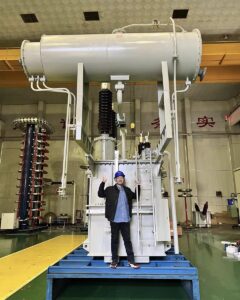Power transformer failures can stop your operations completely. Without a replacement plan, you risk weeks or even months of downtime that could devastate your business.
Replacing a standard power transformer typically takes 2-3 days for the physical installation process once the equipment is on-site. However, if you need a custom transformer manufactured, lead times can extend to 2-6 months depending on specifications, manufacturer availability, and shipping logistics.

Planning ahead is crucial when it comes to transformer replacements. I've seen many companies caught off guard by the extended lead times required for these critical pieces of equipment, especially with today's supply chain challenges.
How Quickly Can a Transformer Be Replaced?
When your transformer fails unexpectedly, every hour of downtime costs money. The pressure to find a replacement solution quickly becomes overwhelming for facility managers.
Emergency transformer replacements can be completed in as little as 24-48 hours in best-case scenarios with readily available stock units. However, most facilities require specific voltage ratings and configurations that typically extend the complete replacement process to 1-2 weeks minimum.

The speed of transformer replacement depends on several key factors that I've observed through years of experience in the power industry. Availability is the most crucial factor - if you need a standard off-the-shelf transformer that a supplier has in stock, you might get lucky with a quick replacement. However, most commercial and industrial applications require specific configurations that aren't readily available.
Size and complexity also significantly impact replacement timelines. Small pad-mounted distribution transformers are relatively simple to replace, often taking just 1-2 days for the actual installation once the unit is on-site. In contrast, large substation transformers can require specialized heavy equipment, extensive planning, and safety procedures that extend the on-site work to 3-7 days or more.
Location accessibility creates another variable in the timeline equation. Urban installations with good road access might proceed smoothly, while remote locations or facilities with limited access points face logistical challenges that add days to the process. I once worked with a mountain resort that needed a helicopter to deliver their replacement transformer because road access was impossible - this added both complexity and cost to their project.
| Transformer Type | Typical Installation Time | Lead Time if Custom Ordered |
|---|---|---|
| Pole-mounted | 4-8 hours | 1-3 months |
| Pad-mounted distribution | 1-2 days | 2-4 months |
| Medium power substation | 2-5 days | 3-6 months |
| Large power transformer | 5-14 days | 6-12+ months |
How Much Time Does It Take to Install a Transformer?
The prospect of installing a new transformer often raises concerns about extended downtime. Project managers need accurate timelines to minimize disruption to operations.
The physical installation of a transformer typically takes 1-3 days depending on size and complexity. This includes positioning, mounting, connecting primary and secondary wiring, testing, and commissioning. However, site preparation work may add several more days to the overall timeline.
](https://voltoritransformer.com/wp-content/uploads/2025/08/3-transformer-installation-process-in-3d-render-s.png)
Installing a transformer involves much more than simply placing equipment and connecting wires. The process requires careful planning and execution across multiple phases. In my experience overseeing dozens of installations, I've found that site preparation often takes longer than the installation itself. This preparatory work includes pouring concrete pads, establishing proper drainage, installing safety barriers, and ensuring appropriate clearances - all of which can take anywhere from a few days to several weeks depending on the site conditions.
The actual installation day begins with equipment delivery, which requires coordinated logistics and often specialized lifting equipment. For larger transformers weighing several tons, cranes must be scheduled, permits secured, and safety protocols established. The physical placement typically takes 2-8 hours depending on accessibility and transformer size. Once positioned, qualified electricians connect the primary and secondary wiring according to specifications, a process taking anywhere from a few hours for simple installations to 1-2 days for complex systems.
Testing and commissioning represent the final and most critical phase. This includes insulation testing, turns ratio verification, oil quality assessment (for oil-filled units), and operational testing under various load conditions. I never cut corners on this phase, as proper testing prevents future failures. This process typically requires 4-12 hours but may extend longer for sophisticated systems with advanced monitoring and protection features.
| Installation Phase | Typical Duration | Key Considerations |
|---|---|---|
| Site preparation | 2-14 days | Foundations, drainage, barriers, access |
| Equipment delivery | 4-8 hours | Logistics, lifting equipment, permits |
| Physical placement | 2-8 hours | Positioning, leveling, securing |
| Electrical connections | 4-24 hours | Primary/secondary wiring, grounding |
| Testing & commissioning | 4-12 hours | Insulation, ratio, operation tests |
How Long Does It Take a Power Company to Repair a Transformer?
When community power goes out due to transformer issues, residents and businesses feel helpless. Understanding utility company repair timelines helps manage expectations during these frustrating outages.
Power companies typically restore service within 4-24 hours for routine transformer failures. Major equipment failures requiring complete replacement may take 24-72 hours. During widespread outages or disasters, repairs follow a priority system with critical infrastructure first, potentially extending residential restoration to several days.

The repair timeline for power company transformers varies dramatically based on several factors that I've observed through my relationships with utility partners. Utilities maintain emergency response protocols that categorize outages by severity, affected customer count, and impact on critical infrastructure. These protocols determine the deployment speed and resources allocated to specific transformer issues.
Diagnosis often consumes significant time in the repair process. Technicians must safely identify the root cause - whether it's physical damage from storms, equipment failure, or overloading - before determining the appropriate repair strategy. This diagnostic phase typically takes 1-4 hours but can extend longer for complex issues or difficult access locations like remote areas or underground vaults.
Weather conditions substantially impact repair timelines. In my experience working with utilities across Canada, severe weather not only causes more transformer failures but also hampers repair efforts. Ice storms, flooding, or extreme heat can double or triple standard repair times due to safety concerns, access limitations, and the need for specialized equipment. One particular winter storm I witnessed left crews working 16-hour shifts in freezing conditions, yet transformer replacements still took 3-4 days rather than the usual 1-2 days.
Resource allocation during widespread outages follows a structured priority system that utilities rarely deviate from. Hospitals, water treatment facilities, and emergency services receive first priority, followed by facilities serving the largest number of customers. This systematic approach means that transformers serving small residential areas or remote locations often face longer wait times during major outage events.
| Outage Type | Typical Repair Time | Priority Level |
|---|---|---|
| Single transformer (routine) | 4-8 hours | Medium |
| Single transformer (major failure) | 24-72 hours | Medium |
| Multiple transformers (storm damage) | 1-7 days | Based on impact |
| Substation transformer | 2-7 days | High |
| Critical infrastructure transformer | 2-24 hours | Highest |
How Long Will My Power Be Out If a Transformer Blew?
When your lights suddenly go out and you suspect a blown transformer, uncertainty about restoration time creates anxiety. Understanding realistic timelines helps businesses and families make appropriate contingency plans.
For residential customers, power typically returns within 4-8 hours after a transformer failure. Commercial customers may see restoration in 2-6 hours. However, complex failures, parts shortages, or widespread outages can extend downtime to 24-72 hours in some cases.

Power outage duration following transformer failures follows patterns I've documented through years of working with both utilities and end customers. The detection and reporting phase sets the initial timeline - if the failure triggers automatic alerts in the utility's system, response begins immediately. However, in areas without advanced monitoring, the utility may not know about the failure until customers report it, potentially adding hours to the outage duration.
The specific cause of transformer failure dramatically impacts restoration time. Simple fuse issues might be resolved in 1-2 hours, while catastrophic transformer failures requiring complete replacement extend outages significantly. Weather-related damage often creates the longest outages, as I've seen firsthand during ice storms when simple replacements that normally take hours stretched into days due to dangerous working conditions and multiple simultaneous failures overloading utility response teams.
Your location within the power grid hierarchy also affects restoration time. Customers served by transformers on main distribution lines typically see faster repairs than those on secondary lines or remote areas. Similarly, population density plays a role - urban areas with higher customer density generally receive faster response than rural locations. I've worked with remote communities where transformer failures resulted in 48+ hour outages simply due to travel time required for specialized crews and equipment to reach the location.
Business and homeowners should develop realistic contingency plans based on these variables. For critical operations, I always recommend backup power solutions rather than relying solely on quick utility response. The investment in generators or battery backup systems provides insurance against extended outages that, while infrequent, can create significant disruption when they do occur.
| Customer Type | Location | Typical Outage Duration | Factors Affecting Timeline |
|---|---|---|---|
| Residential | Urban | 4-8 hours | Grid position, failure cause |
| Residential | Rural | 8-24+ hours | Travel time, crew availability |
| Commercial | Urban | 2-6 hours | Priority status, redundancy |
| Critical Infrastructure | Any | 1-4 hours | Highest priority, backup systems |
| Industrial | Any | 4-12 hours | Complexity, specialized equipment |
Conclusion
Replacing power transformers typically takes 2-3 days for installation, but procurement of custom units can extend timelines to 2-6 months or more. Planning ahead is essential for avoiding extended downtime.
Voltori Energy delivers custom-engineered power transformers for Canadian renewable energy projects, ensuring reliability with local expertise and certification to all Canadian standards.




